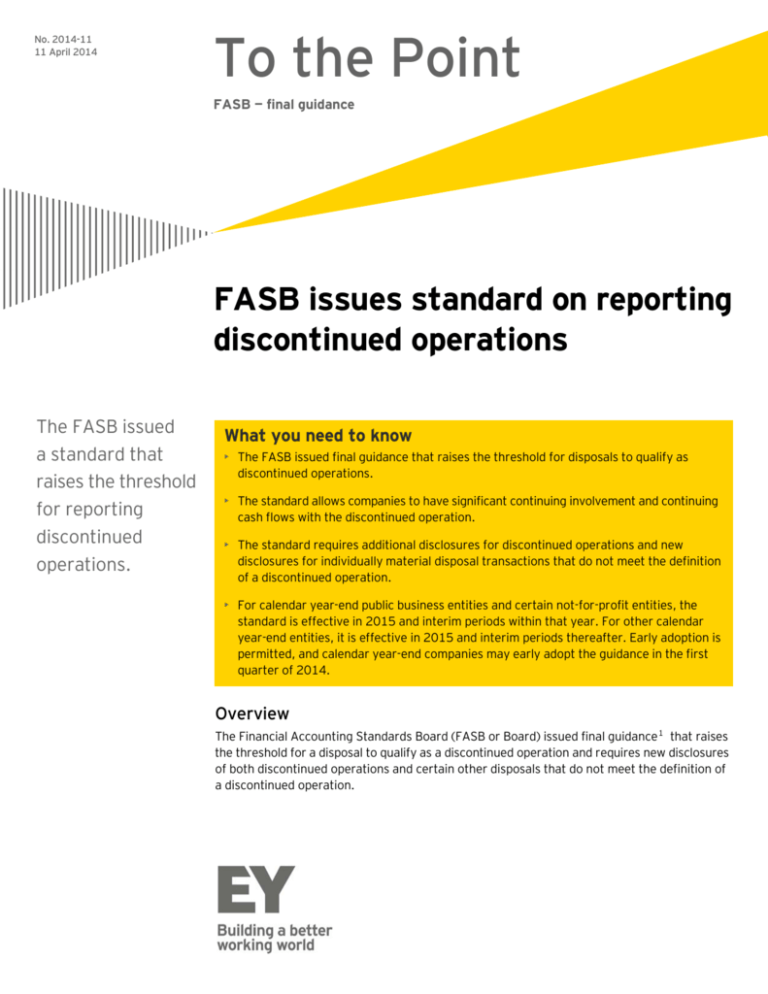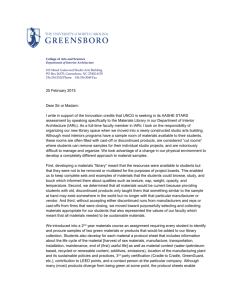
No. 2014-11
11 April 2014
To the Point
FASB — final guidance
FASB issues standard on reporting
discontinued operations
The FASB issued
a standard that
raises the threshold
for reporting
discontinued
operations.
What you need to know
• The FASB issued final guidance that raises the threshold for disposals to qualify as
discontinued operations.
• The standard allows companies to have significant continuing involvement and continuing
cash flows with the discontinued operation.
• The standard requires additional disclosures for discontinued operations and new
disclosures for individually material disposal transactions that do not meet the definition
of a discontinued operation.
• For calendar year-end public business entities and certain not-for-profit entities, the
standard is effective in 2015 and interim periods within that year. For other calendar
year-end entities, it is effective in 2015 and interim periods thereafter. Early adoption is
permitted, and calendar year-end companies may early adopt the guidance in the first
quarter of 2014.
Overview
The Financial Accounting Standards Board (FASB or Board) issued final guidance 1 that raises
the threshold for a disposal to qualify as a discontinued operation and requires new disclosures
of both discontinued operations and certain other disposals that do not meet the definition of
a discontinued operation.
EY AccountingLink | www.ey.com/us/accountinglink
The Accounting Standards Update (ASU) is aimed at reducing the frequency of disposals
reported as discontinued operations by focusing on strategic shifts that have or will have a
major effect on an entity’s operations and financial results. In another change from current
US GAAP, the guidance permits companies to have continuing cash flows and significant
continuing involvement with the disposed component. The new definition of a discontinued
operation more closely aligns US GAAP with IFRS.2
The ASU eliminates most of the scope exceptions in current US GAAP. Only oil and gas
properties accounted for using the full cost method of accounting remain out of the scope of
the revised standard.
Key considerations
Criteria for reporting discontinued operations
Under the revised standard, a discontinued operation is (1) a component of an entity 3 or group
of components that has been disposed of by sale, disposed of other than by sale4 or is classified
as held for sale5 that represents a strategic shift that has or will have a major effect on an
entity’s operations and financial results or (2) an acquired business 6 or nonprofit activity7
that is classified as held for sale on the date of the acquisition.
A strategic shift that has or will have a major effect on an entity’s operations and financial
results could include the disposal of (1) a major line of business, (2) a major geographical
area, (3) a major equity method investment or (4) other major parts of an entity.
Under current US GAAP, an entity is prohibited from reporting a discontinued operation if it
has certain continuing cash flows or involvement with the component after the disposal. The
new guidance eliminates these criteria.
How we see it
The ASU provides examples of strategic shifts without providing guidance on how to
determine whether such a shift has occurred. The guidance also does not define what
constitutes a major effect on an entity’s operations and financial results. We therefore
believe that companies will have to carefully consider the circumstances and effects of
planned and completed disposal transactions to determine whether a disposed operation
or an operation that is held for sale meets the new definition of a discontinued operation.
Presentation and disclosure
The guidance does not change the presentation requirements for discontinued operations in
the statement where net income is presented. Although it permits significant continuing
involvement, the standard does not address how companies should present continuing
involvement with a discontinued operation prior to the disposal. Also, the ASU requires the
reclassification of assets and liabilities of a discontinued operation in the statement of
financial position for all prior periods presented.
The standard expands the disclosures for discontinued operations and requires new disclosures
related to individually material disposals that do not meet the definition of a discontinued
operation, an entity’s continuing involvement with a discontinued operation following the
disposal date and retained equity method investments in a discontinued operation.
2 | To the Point FASB issues standard on reporting discontinued operations 11 April 2014
EY AccountingLink | www.ey.com/us/accountinglink
Effective date
For public business entities and not-for-profit entities that have issued or are conduit bond
obligors for securities that are traded, listed or quoted on an exchange or an over-the-counter
market, the guidance is effective for annual periods beginning on or after 15 December 2014
and interim periods within that year. For other entities, it is effective for annual periods
beginning on or after 15 December 2014 and interim periods within annual periods beginning
on or after 15 December 2015. The ASU is applied prospectively. Early adoption is permitted
but only for disposals (or classifications as held for sale) that have not been reported in
financial statements previously issued or available for issue.
Endnotes:
1
2
3
4
5
6
7
EY | Assurance | Tax | Transactions | Advisory
© 2014 Ernst & Young LLP.
All Rights Reserved.
SCORE No. BB2738
ey.com/us/accountinglink
ASU 2014-08, Reporting Discontinued Operations and Disclosures of Disposals of Components of an Entity.
Paragraph 32 of IFRS 5, Non-current Assets Held for Sale and Discontinued Operations.
A component of an entity comprises operations and cash flows that can be clearly distinguished, operationally and
for financial reporting purposes, from the rest of the entity. A component of an entity may be a reportable segment
or an operating segment, a reporting unit, a subsidiary or an asset group.
ASC 360-10-45-15 provides guidance for long-lived assets to be disposed of other than by sale (e.g., by abandonment
or in a distribution to owners in a spin-off).
ASU 2014-08 paragraph 205-20-45-1E provides the criteria used to determine whether a component of an entity
or a group of components of an entity, a business or a nonprofit activity is classified as held for sale. The criteria
mirror existing guidance in 360-10-45-9.
ASU 2014-08 defines a business the same way as ASC 805, Business Combinations. That is, a business is an
integrated set of activities and assets that is capable of being conducted and managed for the purpose of providing
a return in the form of dividends, lower costs or other economic benefits directly to investors or other owners,
members or participants.
A nonprofit activity is an integrated set of activities and assets that is capable of being conducted and managed for
the purpose of providing benefits, other than goods or services at a profit or profit equivalent, as a fulfillment of an
entity’s purpose or mission (e.g., goods or services to beneficiaries, customers or members). As with a not-for-profit
entity, a nonprofit activity possesses characteristics that distinguish it from a business or a for-profit business entity.
About EY
EY is a global leader in assurance, tax, transaction and advisory services. The insights and quality services we deliver help build trust and confidence in the
capital markets and in economies the world over. We develop outstanding leaders who team to deliver on our promises to all of our stakeholders. In so doing,
we play a critical role in building a better working world for our people, for our clients and for our communities.
EY refers to the global organization, and may refer to one or more, of the member firms of Ernst & Young Global Limited, each of which is a separate legal
entity. Ernst & Young Global Limited, a UK company limited by guarantee, does not provide services to clients. For more information about our organization,
please visit ey.com.
Ernst & Young LLP is a client-serving member firm of Ernst & Young Global Limited operating in the US.
This material has been prepared for general informational purposes only and is not intended to be relied upon as accounting, tax, or other professional advice. Please refer to your advisors for specific advice.
3 | To the Point FASB issues standard on reporting discontinued operations 11 April 2014







